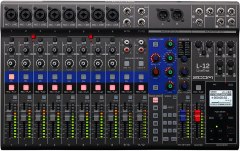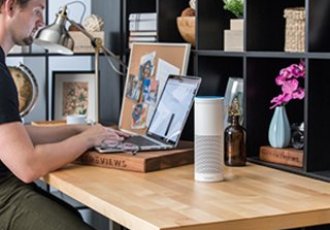BestReviews is reader-supported and may earn an affiliate commission. Details

This unit features eight mono channels and two stereo for podcasts, music, video sounds, and more.
This unit features eight mono channels and two stereo for podcasts, music, video sounds, and more.
A simple but comprehensive unit that doesn't take up too much space. Connect up to five headphones at once. Scene-saving function lets you save up to nine at once. Buyers laud its comprehensive feature set for such a portable unit.
Some reports of sound bleeding through channels.

The simple controls combined with a decent price point make this a great option for those looking to start mixing.
The simple controls combined with a decent price point make this a great option for those looking to start mixing.
The LCD controls are easy to change so that you have access to podcast, music, and game streaming options at the press of a button. Allows you to switch between various setups without having to reprogram. Comes with both Streamdeck and Wave Link software.
It may take a few moments from startup for the buttons to display what you need.

Designed to work with any audio setup, this small mixer is perfect for looping beats or recording vocals.
Designed to work with any audio setup, this small mixer is perfect for looping beats or recording vocals.
Comes equipped with exceptional preamps that help provide booming bass. Able to control EQ directly from the board so you can separate vocals from instruments in a balanced way regardless of the recording. Auto compresses the music as it is recorded.
Some users noted that the volume control for headphones was a little low.

This small mixer packs a professional punch while being small enough to take out on the road with your laptop.
This small mixer packs a professional punch while being small enough to take out on the road with your laptop.
USB/flash ready for your computer with built-in controls for track-mixing, playing, and pausing. Wirelessly stream your audio thanks to onboard Bluetooth. Includes a powerful 100V adapter for incredible performance. Steel chassis should survive life out on the road.
No mic mute, which may not be the best for podcasters.
This model has standard controls for music, streaming, podcasting, chat, and more.
This model has standard controls for music, streaming, podcasting, chat, and more.
Part multi-channel mixer, part preamp, part sampler—this unit does a little bit of everything. TC-Helicon is a favorite among musicians and podcasters for its simple and beautiful design. Easy-access buttons make everything simple. Great for streamers
While many musicians love this unit, some may want more control than this offers.

We recommend these products based on an intensive research process that's designed to cut through the noise and find the top products in this space. Guided by experts, we spend hours looking into the factors that matter, to bring you these selections.

How do you tie together several different instruments into a single, cohesive sound when you need to amplify everyone? The trusty audio mixer is your secret weapon to making any music group sound clear and balanced. Whether you are playing live or making a recording, an audio mixer is one of the most important pieces of equipment you can buy.
What kind of audio mixer should you buy? That is the $100 question – or the $1,000 question, depending on what your budget and needs are. Sound mixers come with many different price tags for hobbyists and professionals alike. While each one does the job of bringing multiple instruments and sound sources together, they all have different specs and features that may be more or less useful to you.
To decide what you need, it helps to have a shopping guide you can refer to. That is where BestReviews comes in. To save you time and money, we have compiled this audio mixer shopping guide and review based on hours of research.
If you need to purchase your first audio mixer or upgrade an existing one, this guide will help you identify and understand the important features you may need. Read on to see what kind of audio mixer can take your sonic masterpieces to the next level.

The traditional audio mixer is the heart of any live or recorded performance ensemble. Typically, when different instruments are plugged in and amplified, they need a central source to control volume levels and effects. Otherwise, some instruments would sound louder than others, and the entire group would be off-balance.
An audio mixer works by connecting all electrified instruments and microphones together. It provides different controls to change volume and different effects so you can set the overall balance between individual sounds. Best of all, audio mixers can be changed on the go.
You will find a number of different types of audio mixers to choose from. Large or small, simple or complex, they all do the same job.
As with most music and audio equipment, you will find differences between audio mixers meant for the weekend hobbyist and audio mixers meant for the working professional. Hobby audio mixers typically cost less and are quite straightforward. They’re also more limited in the number of audio sources and settings they provide. Most portable and budget-friendly audio mixers fall in this category.
Most of the time, audio mixers meant for professionals are larger with more features and inputs. They are designed to give the professional the greatest amount of control and capability possible during live and recorded performances.
When choosing between a hobby and professional sound mixer, think about how you will use the equipment. How often do you perform or record music? How large is the group you want to amplify? Your answers should help guide your decision.
Perhaps the most important feature of an audio mixer is the number of inputs and channels it provides. An input is simply a plug you can connect any sound source to, such an electric instrument or a microphone. This connection allows you to control volume and sound. A channel is a set of controls that affects a specific input.
Most audio mixers come with inputs and channels that allow you to control a large number of sound sources at once. Typically coming in even numbers, cheaper mixers may have two to eight inputs and controls. Bigger, more professional mixers will usually come with a larger number of inputs ranging from 32 to 64.
Audio mixers do more than just control the volume of the instruments and microphones you connect. In fact, they can change the overall sound of an instrument with just a few twists and turns of a knob. Most audio mixers offer similar setting options, with professional mixers giving you finer control over the sound.
Common special effects include the following.
Equalization: This allows you to adjust the volume of different frequencies, usually separated into low, medium, and high, so you can customize the sound of a source. Equalization is manipulated with sliders or knobs on the mixer itself.
Echo: You can create a literal echo effect so the sound seems like it is in a larger space. It is commonly found on most audio mixers as a single knob.
Reverb: This is a more subtle version of an echo that adds depth to the vocals or instruments without sounding like a cave or hall.
The old-school audio mixers of the past were the size of tables. Suffice it to say, you would not be moving these mixers around on a daily basis. Today, however, digital audio mixers can be small enough to fit in your pocket.
Portable audio mixers are a great option when you’re performing on the go. Some portable mixers are the size of laptops with between 8 and 16 input channels. You could go even smaller with a handheld audio mixer, which may have 2 or 4 channels. These are common in video and audio recording environments.
Computers have changed how people record audio. More audio engineers and musicians use computers since this is a more affordable way to record and edit audio. To use an audio mixer with digital music production, the mixer itself needs some way to talk with the computer. The most common way is with a built-in USB interface. The audio mixer plugs into the computer via USB cord and acts as a controller for your audio software.
The other way to hook an audio mixer up to a computer is through an audio output jack. Located on the back of most mixers, this port feeds a cable to your computer’s sound card or audio interface. The downside to this method is you cannot record individual channels. The audio software treats all microphones and instruments as one source.
If you plan to actually record the sounds or music that you control in your mixer, you will need some sort of recording device to turn the sound into a digital file. Most mixers focus on shaping the sound as it is played, not recording it.
But some small, portable audio mixers include an audio recorder. These all-in-one solutions are typically limited in the number of inputs you can record at the same time, but they give you basic control over starting and stopping the recording. These are great for video production and recording yourself while singing or playing an instrument, narrating voice overs, or doing other individual audio work at home.
As with any piece of audio equipment, you get what you pay for with audio mixers. Pricier options come with more inputs, more features, and better build qualities.
Budget mixers start around $30 and quickly climb up to $100 or $200. For this price, you will find many great portable and small options with a few dedicated channels and effects. If you need more inputs, be prepared to spend $100 to $300 for a small yet more professional mixer. Many touring musicians like to take this sort of equipment on the road.
Home recording studios can benefit from mid-range to premium audio mixers that cost upwards of $300. These audio mixers have the greatest number of inputs, channels, built-in effects, and controls.
Don’t choose an audio mixer with more inputs than you would normally use.
If you have a small mixer with limited inputs, you may choose to record individual sources independently.
Medium-size mixers are good for small-to-medium bands in live performance settings.
For a home studio, opt for a larger audio mixer or a USB controller, if you record into a computer.

Q. Are professional audio mixers better?
A. While professional audio mixers will give you more inputs, effects, and controls, they aren’t necessarily better. Budget and hobby-level audio mixers can do a great job of mixing sounds together if you don’t need a lot of advanced features.
Q. How many inputs do I need?
A. That depends on the size of the group. For personal use, two or four inputs should be fine. Most bands don’t need more than eight inputs. Large groups can use 16 or 32.
Q. Which effects should I use on my audio mixer?
A. Most of the time, you don’t need any effects to get a great sound. Basic effects, like reverb and echo, can be used for a fuller presence.
Get emails you’ll love.
Learn about the products you’re wondering if you should buy and get advice on using your latest purchases.
